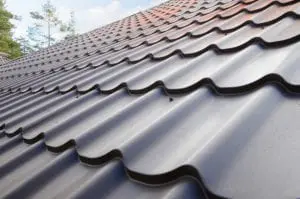
What is the Longest Lasting Roof Material?
When it comes to choosing roofing materials for your home, longevity is a key factor. After all, a roof is more than just a cover over your head; it’s a long-term investment. But with so many options available, you might be wondering, “What is the longest-lasting roof material?” Let’s dive into this topic and uncover the materials that offer durability and longevity, ensuring your home stays protected for years to come.
Exploring Durable Roofing Materials
Metal Roofing: A Blend of Durability and Style
Metal roofs, known for their exceptional longevity, can last anywhere from 40 to 70 years. Their durability is largely due to their resistance to extreme weather conditions. From corrugated steel panels to sleek standing seam designs, metal roofs aren’t just tough; they’re also stylish and versatile.
Slate Roofing: The Century-Old Guardian
Slate roofing is often considered the gold standard in terms of lifespan. A well-installed slate roof can last over 100 years! Slate’s natural stone composition makes it incredibly durable, resistant to fire, rot, and pests. Its classic, elegant appearance has graced historical and luxury homes for centuries.
Clay and Concrete Tiles: The Time-Tested Classics
Clay and concrete tile roofs are renowned for their longevity and can last 50 to 100 years. These materials are particularly popular in regions with hot climates or where a Spanish-style aesthetic is desired. They are excellent at resisting heat, though they do require a sturdy structure to support their weight.
Synthetic Roofing: The Modern Contender
In recent years, synthetic roofing materials like rubber and plastic have gained popularity. These materials can mimic the look of slate or wood and are known for their durability, often lasting 50 years or more. They are lightweight, making them a versatile option for a variety of structures.

Factors Contributing to a Roof’s Longevity
While the material is a significant factor in a roof’s lifespan, several other factors play a role:
- Quality of Installation: A roof’s lifespan is greatly influenced by the quality of its installation. Expert installation can maximize the longevity of even the most durable materials.
- Climate: The local climate can impact the longevity of roofing materials. For instance, metal roofs are excellent for snowy areas, while clay tiles are ideal for hot, sunny climates.
- Maintenance: Regular maintenance can extend the life of any roofing material. This includes cleaning gutters, inspecting for damage, and timely repairs.
Choosing the longest-lasting roof material depends on various factors, including your climate, home’s structure, and aesthetic preferences. Whether it’s the timeless elegance of slate, the versatility of metal, the classic charm of clay tiles, or the innovative appeal of synthetic materials, your choice of roofing should be one that promises durability and complements your home for years to come.
Considering What You’re Looking for in Roof Material
While longevity is undoubtedly a crucial factor when selecting roofing material, it’s not the only aspect to consider. A roof is a significant architectural element of your home, and various factors contribute to finding the perfect roofing solution. Let’s explore other important benefits and features of roofing materials that homeowners should consider.
Aesthetics and Architectural Style
Your home’s architectural style plays a pivotal role in choosing the right roof material.
- Traditional Homes: Classic materials like slate and clay tiles complement traditional home styles, adding to their historical or regional charm.
- Modern and Contemporary Homes: Metal roofing or even certain synthetic materials can offer clean, sleek lines that suit modern aesthetics.

Environmental Impact and Energy Efficiency
Consider the environmental footprint and energy efficiency of the roofing material.
- Eco-Friendly Options: Materials like metal roofing are often made from recycled content and are fully recyclable at the end of their life.
- Energy Efficiency: Some materials reflect sunlight better than others, helping to keep homes cooler and reduce energy costs. For instance, white or light-colored metal roofing can be highly energy-efficient.
Weight and Structural Considerations
The weight of the roofing material can impact your choice, especially if your home has structural limitations.
- Heavy Materials: Slate and clay tiles are heavy and often require additional structural support.
- Lightweight Options: Materials like metal or synthetic products are lightweight, making them suitable for a wider range of structures without needing extra reinforcement.
Cost and Budget
Your budget is a significant factor in the decision-making process.
- Initial vs. Long-Term Cost: While some roofs may have higher upfront material costs, like slate, their longevity can make them cost-effective over time. On the other hand, options like asphalt shingles offer immediate affordability.
Weather Resistance and Local Climate
The local climate should heavily influence your roofing material choice.
- Harsh Winters: In areas with heavy snowfall, metal roofs can be beneficial due to their ability to shed snow and ice quickly.
- Hot Climates: Tile roofs can withstand high temperatures and are ideal for sunny areas.
Maintenance Requirements
Consider the level of maintenance you’re willing to commit to.
- High Maintenance: Materials like wood shakes are beautiful but require regular maintenance to prevent issues like rot or insect infestation.
- Low Maintenance: Metal and synthetic roofs usually require minimal upkeep, making them convenient for homeowners who prefer less maintenance.
Choosing the right roofing material for your home involves balancing various factors, including aesthetics, environmental impact, weight, cost, local climate, and maintenance requirements. It’s about finding the best fit for your home’s style, your personal preferences, and practical needs. Remember, your roof is not just a functional necessity; it’s a long-term investment in your home’s value and comfort.

Navigating Warranty and Lifespan Guarantees
Another critical aspect to consider when selecting your roofing material is the warranty and lifespan guarantees offered. This often overlooked feature can provide peace of mind and protect your investment in the long run.
Understanding Roofing Warranties
- Manufacturer’s Warranty: This typically covers defects in the roofing material. The duration and specifics can vary greatly depending on the material and brand.
- Workmanship Warranty: Offered by the roofing contractor, this covers errors in installation. The length and terms of these warranties can differ, so it’s important to understand the details.
The Importance of Lifespan Guarantees
- Long-Term Security: A good warranty can offer assurance that your investment is protected against unforeseen issues.
- Resale Value: If you plan to sell your home in the future, a transferable roof warranty can be an attractive selling point to potential buyers.
Tips for Warranty Considerations
- Read the Fine Print: Understand what’s covered and what’s not. Some warranties may have specific maintenance requirements to remain valid.
- Professional Installation: Ensure your roof is installed by licensed professionals, as improper installation can void warranty coverage.

Balancing Functionality with Personal Style
While functionality is paramount, your roof is also a significant element of your home’s curb appeal.
Personal Style and Curb Appeal
- Complementing Your Home’s Look: Choose a roofing material that not only meets your functional needs but also enhances the overall appearance of your home.
- Color and Texture Options: Many materials come in a variety of colors and textures. Consider how these options can accentuate your home’s architectural style.
The Role of Roofing in Home Character
- Defining Character: A roof can define the character of your home. For example, wooden shingles can add a rustic charm, while slate tiles can lend an air of elegance and sophistication.
Making the Environmentally Conscious Choice
For those keen on minimizing environmental impact, certain roofing materials stand out.
Eco-Friendly Roofing Options
- Recycled Materials: Some metal roofs are made from recycled materials and are fully recyclable at the end of their lifespan.
- Reflective Coatings: Certain materials come with reflective coatings that can reduce heat absorption, lowering cooling costs and benefiting the environment.
Solar-Ready Roofs
- Future Solar Installations: If you’re considering solar panels, ensure your chosen roofing material is compatible and can support the installation.
Choosing the right roofing material for your home is a multifaceted decision. It’s about striking the right balance between longevity, aesthetics, budget, and environmental considerations. With the right information and a thoughtful approach, you can select a roof that not only protects your home but also complements its style, aligns with your values, and fits your budget.

Trending Roofing Materials and Designs
When planning a long-term roof replacement, it’s wise to consider the current trends in roofing materials and designs, especially those popular for your type of home. Trends not only reflect the evolving aesthetic preferences but often incorporate advancements in durability, energy efficiency, and eco-friendliness. Let’s explore what’s trending in the roofing world and why these choices might be suitable for your home.
Metal Roofing: The Modern Choice
Metal roofing has surged in popularity, thanks to its blend of durability, energy efficiency, and sleek appearance. Ideal for modern and contemporary homes, metal roofs come in various finishes and colors, offering versatility in design while providing excellent longevity and weather resistance.
Why It’s Trending:
- Energy Efficiency: Metal roofs reflect solar radiant heat, reducing cooling costs.
- Longevity: Resistant to cracking, shrinking, and eroding, metal roofs can withstand extreme weather conditions.
- Eco-Friendly: Often made from recycled materials and fully recyclable.
Synthetic Roofing: Innovation at Its Best
Synthetic roofing materials, like rubber and polymer, are gaining traction. They mimic the look of natural materials like slate or wood but offer enhanced durability and less maintenance.
Why It’s Trending:
- Versatility: Comes in various styles and colors.
- Durability: Resistant to weathering, UV rays, and thermal splitting.
- Lightweight: Easier and often cheaper to install than traditional materials.
Green Roofing: Eco-Conscious Living
Green roofs, covered with vegetation, are an innovative trend, particularly in urban settings. They not only provide a unique aesthetic but also offer environmental benefits.
Why It’s Trending:
- Environmental Impact: Improves air quality and reduces the urban heat island effect.
- Insulation: Offers natural insulation, reducing heating and cooling costs.
- Biodiversity: Supports local wildlife and biodiversity.

Architectural Shingles: The New Standard in Shingle Design
Architectural shingles, a premium type of asphalt shingle, are known for their dimensional appearance. They are an upgrade from the traditional flat asphalt shingles, offering a contoured, textured look.
Why It’s Trending:
- Aesthetic Appeal: Provides a high-end look at a relatively affordable price.
- Durability: Typically heavier than standard shingles and offers better wind resistance.
- Variety: Available in a wide range of colors and styles.
Why Popular Roofing Trends Matter
When choosing a roof, it’s essential to consider these trends, as they often reflect advancements in roofing technology and changing architectural styles. Here’s why staying in touch with roofing trends is important:
- Resale Value: Homes that align with current trends often have better resale value.
- Community Aesthetics: In many neighborhoods, especially those with homeowners’ associations, keeping up with trends ensures that your home fits in aesthetically with the community.
- Innovation Benefits: Trending materials often come with the benefits of recent innovations in roofing technology, such as improved energy efficiency and eco-friendliness.
In the world of roofing, trends offer more than just aesthetic appeal; they bring together the best in technology, sustainability, and design. When considering a long-term roof replacement, look at what’s trending, but also consider what suits your home’s style, your personal preferences, and your environmental values. With the right choice, your new roof can be a statement of both style and substance.
Still weighing your options for the perfect roofing material? Our team is here to help guide you through the choices and find the roofing solution that best fits your home’s needs and your personal preferences.




Leave a Reply